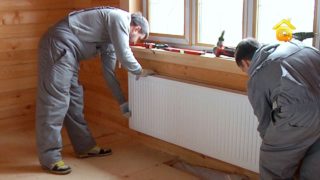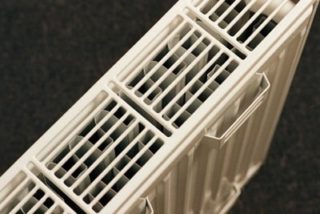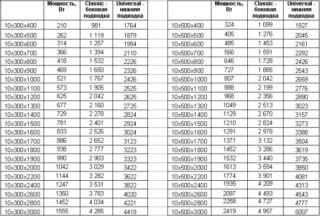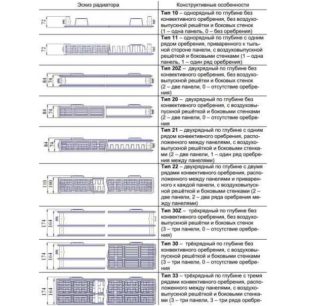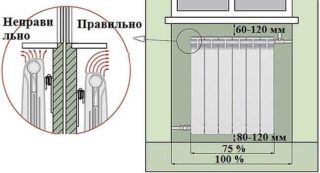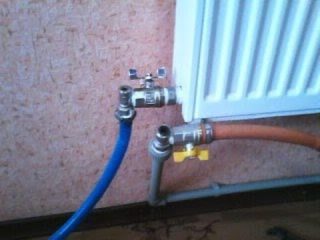Steel radiators Prado manufactures NITI Progress. Production facilities are located in the city of Izhevsk. The design of the heating devices was developed by Russian specialists. The first batch appeared on the market in 2005. At a modern enterprise, stamping processes are automated, high-quality welding technologies are used. The production of panel radiators is constantly monitored. Products are not inferior in quality to foreign analogues.
The main advantages of radiators
Prado steel heat exchangers are designed for water heating systems. They are installed in private homes, administrative and public buildings. The products are suitable for single pipe and double pipe systems. They consist of two stamped blanks with a thickness of 1, 2 mm, connected by spot welding. Inside the device channels are formed for the coolant. Along the perimeter, the radiator parts are welded with a continuous seam. A grille is installed on top, allowing warm air to pass through unhindered. Finished products are enclosed in a film that protects them during transportation and installation.
Prado radiators have advantages over aluminum and cast-iron models of heating appliances.
- Devices are made of corrosion resistant materials.
- The use of steel fins to increase heat transfer.
- The durability and reliability of the coloring made by the method of electric submersible anaphoresis.
- The Prado heating radiator withstands pressure up to 13.5 atmospheres, a nominal rating of 9 atmospheres.
- Attractive and ergonomic design. For individual orders, you can choose a color that suits the gamut of the interior.
- The light weight of the devices allows you to fix them on the wall of drywall.
The use of antifreeze is allowed as a coolant. Unlike aluminum batteries, Prado products do not have rubber parts that are destroyed by aggressive liquids.
Heaters are sold fully operational. They are equipped with plugs, thermostatic valves, Mayevsky taps. The set includes mounting brackets.
Specifications
When connecting Prado heating appliances to the apartment building system, it is necessary to find out the connection diagram. With independent water treatment using steel radiators, there will be no difficulties. If the circuit is dependent, the parameters of the coolant are first recognized. Products are designed for the following characteristics:
- working pressure - 0.9 MPa, for models with a panel of 1.4 mm - 1 MPa;
- maximum heat carrier temperature - 120 ° C;
- panel weight 300 mm high - from 2.95 to 119.99 kg;
- panel weight 500 mm high - from 8.18 to 89.84 kg;
- permissible pH values - 8.3-9;
- 1/2 ″ female threads.
The best choice for radiators is closed heating systems. They reduce the effect of corrosion on steel. Dimensions of devices:
- height - 300 and 500 mm;
- length from 400 to 3000 mm;
- depth - 80-200 mm.
Depending on the model, the radiators are equipped with convection fins. Corrugated steel sheet is welded to the vertical channels. The power of the heating device increases. An air outlet grille and side trims are installed as trim. The number and parameters of radiators are selected based on the area of the heated room.
The lineup
The catalog of the company presents Classic and Universal models.Products are available with side and bottom eyeliner. The manufacturer offers a wide range of sizes, allowing you to design the optimal heating system. Structurally, the devices consist of one, two or three panels, plus finning. The catalog of the company presents several types of radiators. They differ in depth, number of panels, the presence of fins.
Varieties of Prado batteries:
- Type 10 is the narrowest model (72 mm), consisting of one row of panels. Its plus is its affordable cost. The minuses include a small heating power.
- Type 11 - fins are welded to the back of a single-row panel. The product is equipped with an air outlet grill and side trims.
- Type 20 - a radiator with two panels, but without convection fins. There is a grill on top. Depth 82 mm.
- Type 21 - the model consists of two panels and fins between them. The heater received all the necessary finishes - a grill and side inserts.
- Type 22 - stamped parts are arranged in two rows, a ribbed convector is welded to each. The depth of the product is 108 mm, a grill is installed on top, on the sides of the bar.
- Type 30 - a three-row radiator that does not have fins. The model with the letter "Z" is offered without a grille and sidewalls. Option with the letter "V" with vertical connection.
- Type 33 - three rows of finned panels form a depth of 172 mm. The radiator is fully equipped with finishing elements.
Prado classic
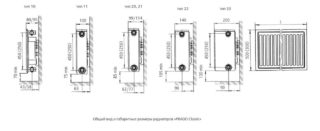 Radiators Prado Classic are used in two-pipe and single-pipe communication networks. They can be installed in gravity systems and functioning with pumping stations. On four sides of the product there are holes for lateral piping. Classic radiators are available in all types. Their feature is the lack of right and left execution. The heater can only be connected on one side, and a plug is placed on the second.
Radiators Prado Classic are used in two-pipe and single-pipe communication networks. They can be installed in gravity systems and functioning with pumping stations. On four sides of the product there are holes for lateral piping. Classic radiators are available in all types. Their feature is the lack of right and left execution. The heater can only be connected on one side, and a plug is placed on the second.
For institutions with increased requirements for cleanliness, Z-hygienic series heaters are designed. They are devoid of fins, side walls and grilles. When marking products, their type and dimensions are indicated. For example: Prado Classic 22-500-500 model - radiator with side connection type 22, length 500 mm, width 500 mm.
Prado universal
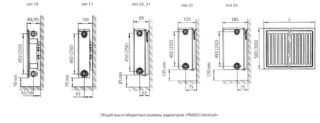 The advantage of the versatile battery is a universal eyeliner. The design allows for lower connection by hiding the heating pipe. The option of switching through 4 connecting holes in the corners of the device. Products are made of various types, from single-row to three-row. There is also a Z series of hygienic heating appliances. The devices are equipped with connecting pipes on the right and left sides, which simplifies installation. Steel Prado Universal radiators are equipped with Danfoss thermostats that control their power. Valves are designed for a two-pipe system. When installing batteries in a one-pipe network, models with a reduced resistance to the thermostat are selected.
The advantage of the versatile battery is a universal eyeliner. The design allows for lower connection by hiding the heating pipe. The option of switching through 4 connecting holes in the corners of the device. Products are made of various types, from single-row to three-row. There is also a Z series of hygienic heating appliances. The devices are equipped with connecting pipes on the right and left sides, which simplifies installation. Steel Prado Universal radiators are equipped with Danfoss thermostats that control their power. Valves are designed for a two-pipe system. When installing batteries in a one-pipe network, models with a reduced resistance to the thermostat are selected.
Installation and operation
Installation of panel radiators takes place in a short time. They are sold assembled, it remains only to hang the device on the wall and attach to the pipes. Placement of devices is carried out according to the norms of SNiP. According to the document, the distance from the floor to the bottom of the panel should be 7-20 cm, depending on the type of product. Batteries are usually installed under windows. According to the instructions, the distance from the window sill is from 7 cm.
Panel radiators are installed after finishing work. Their fastening is carried out on branded brackets that come with the kit. Details allow you to fix the gap between the wall and the device.
Installation sequence:
- Mark to fix fasteners.
- Fix the brackets with dowels or seal into cement mortar.
- Remove the film at the points where the appliance is connected to the pipes.
- Hang the radiator on the mounting shelf.
- Connect the appliance to the heating pipes.
- Install an air vent in the upper pipe.Close unused outputs with plugs.
- The station wagon radiators install a temperature regulator.
- Fill the system with coolant through the return line to avoid air congestion.
When installing devices with a length of more than 1400 mm, experts recommend a diagonal connection. The coolant is supplied from above, and exits from the opposite side from below.
Operational Features
Panel radiators have a small section of vertical channels. This affects the sensitivity to coolant contamination. A liquid with a large number of suspensions and impurities will quickly clog the collectors. In individual systems it is easy to control the quality of the coolant used, in apartment buildings you will have to install filters for trapping dirt.
The manufacturer does not recommend draining water from appliances for more than 15 days a year. Prolonged absence of fluid causes rapid corrosion of the metal. Radiators must be washed at least 3-4 times a year. Do not use abrasive materials.
Prado radiators are popular among consumers for their reliability, long service life and high heat dissipation.
